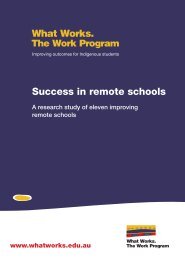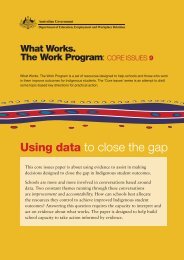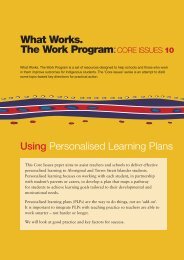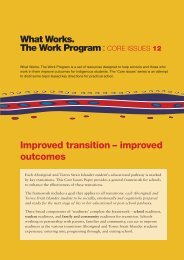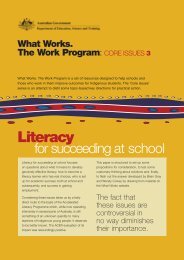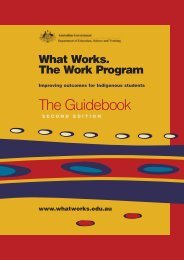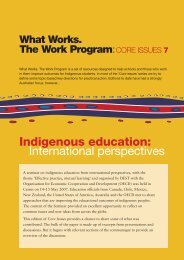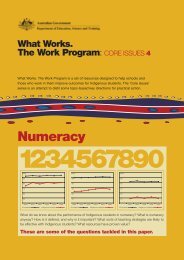Bound for Success Scope and Sequence Statements
Bound for Success Scope and Sequence Statements
Bound for Success Scope and Sequence Statements
- No tags were found...
You also want an ePaper? Increase the reach of your titles
YUMPU automatically turns print PDFs into web optimized ePapers that Google loves.
SCIENCEEarth <strong>and</strong> BeyondConcept In Year 1the student:In Year 2the student:In Year 3the student:In Year 4the student:In Year 5the student:In Year 6the student:In Year 7the student:In Year 8the student:In Year 9the student:There arerelationships betweenthe Earth, our solarsystem <strong>and</strong> theuniverse• Knows that some changesin our behaviour dependon the sun (e.g. says “wedon’t swim in winterbecause it’s cold” ).• Knows that we live on aplanet called ‘Earth’ <strong>and</strong>that there are other planets.• Explores relationshipsbetween distance <strong>and</strong>apparent size of objects.Underst<strong>and</strong>s that the sun ismany times bigger than theearth but appears muchsmaller because it is so faraway. Underst<strong>and</strong>s that themoon is much smaller thanthe Earth <strong>and</strong> tinycompared to the sun but itappears to be comparableto the size of the sunbecause it is closer to theEarth than the sun.• Knows that our solarsystem is made up of thesun <strong>and</strong> eight planetsincluding Earth.• Knows that there are sevenother planets besides theEarth in our solar system<strong>and</strong> that all of these aredifferent distances awayfrom the Earth <strong>and</strong> allrevolve around the sun –describes this using amodel.• Underst<strong>and</strong>s that the Earthturns slowly on its ownaxis so that sometimes wecan see the sun <strong>and</strong> othertimes we can’t; describesthis using a model.• Underst<strong>and</strong>s that many ofthe other planets are muchgreater in size than theEarth but appear smallerdue to their great distancefrom Earth.• Can name the eight planetsin the solar system in orderof their distance from thesun.• Knows that our sun is astar <strong>and</strong> that all stars are asbright as or brighter than,our sun <strong>and</strong> learns this byinvestigating “doesdistance away from anobject affect itsbrightness?’• Knows that other planetsdo not support life as weknow it here on Earth.• Knows the commonfeatures in the night skyincluding comets <strong>and</strong>meteors [a meteor is afalling star ∗ ] <strong>and</strong> knowsthat we can often see otherplants with a telescope orthe naked eye.• Knows that many stars aremuch greater in size thanour own star, the sun, butappear much smaller dueto the distance from us.• Knows that each of theother seven planets in thesolar system is different toearth in many waysincluding temperature, <strong>and</strong>recognises the immensedistances across the solarsystem.• Knows that the moonaffects the Earth causingtides. Knows that a totaleclipse causes the moon toblock the sun’s rays fromreaching Earth.• Underst<strong>and</strong>s the spatialrelationships between theEarth, Moon <strong>and</strong> Sun.• Knows that the phases ofthe moon are the result ofthe reflection of the sun onthe moon’s surface [thephases of the moon are dueto clouds ∗ ]• Knows that stars <strong>for</strong>mpatterns in the sky but thatthese stars are differentdistances away from theEarth <strong>and</strong> that these are allsuns like our suns but ofdifferent sizes.• Recognises the SouthernCross constellation in thenight sky.• Compares the sizes ofother plants to Earth <strong>and</strong>the relative distances ofthese to each other <strong>and</strong>from the sun; underst<strong>and</strong>sthat some planets havetheir own moon or moons.• Uses a telescope toobserve changes in thenight sky <strong>and</strong> identifiesnearby planets.• Knows the requirements<strong>for</strong> life on earth <strong>and</strong>identifies what would berequired <strong>for</strong> life on otherplanets <strong>and</strong> in space.• Underst<strong>and</strong>s the basicfeatures of each of theeight planets <strong>and</strong> thedifferences between rocky(inner) planets <strong>and</strong> gaseous(outer) planets.• Knows our solar system islocated in the Milky Waygalaxy <strong>and</strong> that there aremillions of other galaxiesthat make up the Universe.• Knows features of theuniverse – e.g. galaxies,comets, asteroids - <strong>and</strong>their relationship to eachother <strong>and</strong> to the universe asa whole.• Considers <strong>and</strong> explainsscientific theories of theorigin of the universe;Explains how man’sknowledge <strong>and</strong>underst<strong>and</strong>ing of theuniverse has developedover time aided by thedevelopment of technology<strong>for</strong> this purpose, includingtelescopes, observatories<strong>and</strong> space travel).• Identifies key figures inthe history of astronomy(Newton, Galileo,Einstein) <strong>and</strong> knows theircontribution.• Comprehends some of thedifficulties of space travel<strong>and</strong> recognizes moderndevelopments in this area.• Knows that things on orabove the Earth’s surfaceare pulled towards it bygravity.• Knows that gravity is a<strong>for</strong>ce that pulls smallerobjects towards largerones, <strong>and</strong> that because thesun is so much bigger thanall the planets this <strong>for</strong>cekeeps the planets in orbitaround the sun.• Knows that the <strong>for</strong>ce ofgravity keeps the moon inorbit around the Earth <strong>and</strong>holds humans to theEarth’s surface.• Knows that gravity is a<strong>for</strong>ce that acts betweenobjects, tending to pullobjects of smaller masstowards objects of largermass.• Knows that gravity keepsthe planets of the solarsystem in their orbitsaround the sun <strong>and</strong> themoon in orbit around theEarth <strong>and</strong> holds humans tothe Earth’s surface.• Know that gravitationalattraction exists betweenall the objects in the SolarSystem.• Knows that all objects inthe solar system areinfluenced by the <strong>for</strong>ce ofgravity – a <strong>for</strong>ce that tendsto pull smaller objectstowards larger ones – <strong>and</strong>that the bigger the object,the greater the <strong>for</strong>ce itexerts on other bodies (e.g.the Sun exerts a very large<strong>for</strong>ce on all the planets; theEarth exerts acomparatively smaller<strong>for</strong>ce on the moon <strong>and</strong> onhumans).∗ identifies common misconceptions in Science<strong>Bound</strong> <strong>for</strong> <strong>Success</strong> <strong>Scope</strong> <strong>and</strong> <strong>Sequence</strong> <strong>Statements</strong> V2 Page 52 Working Document Semester One 2007



